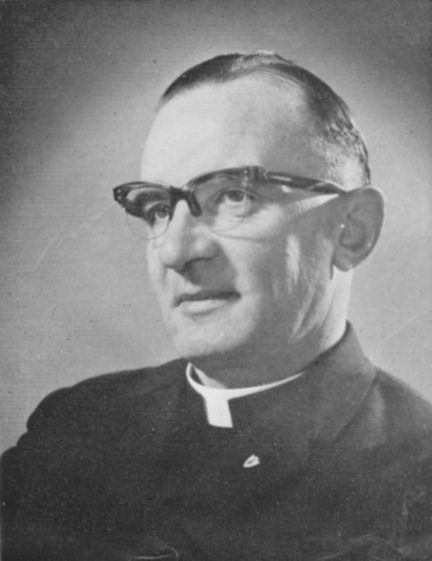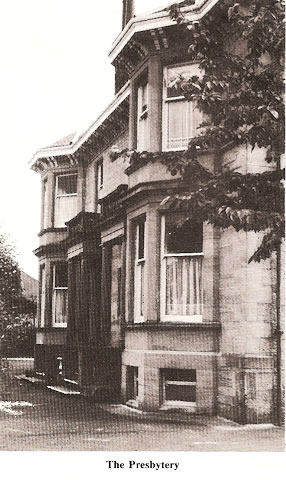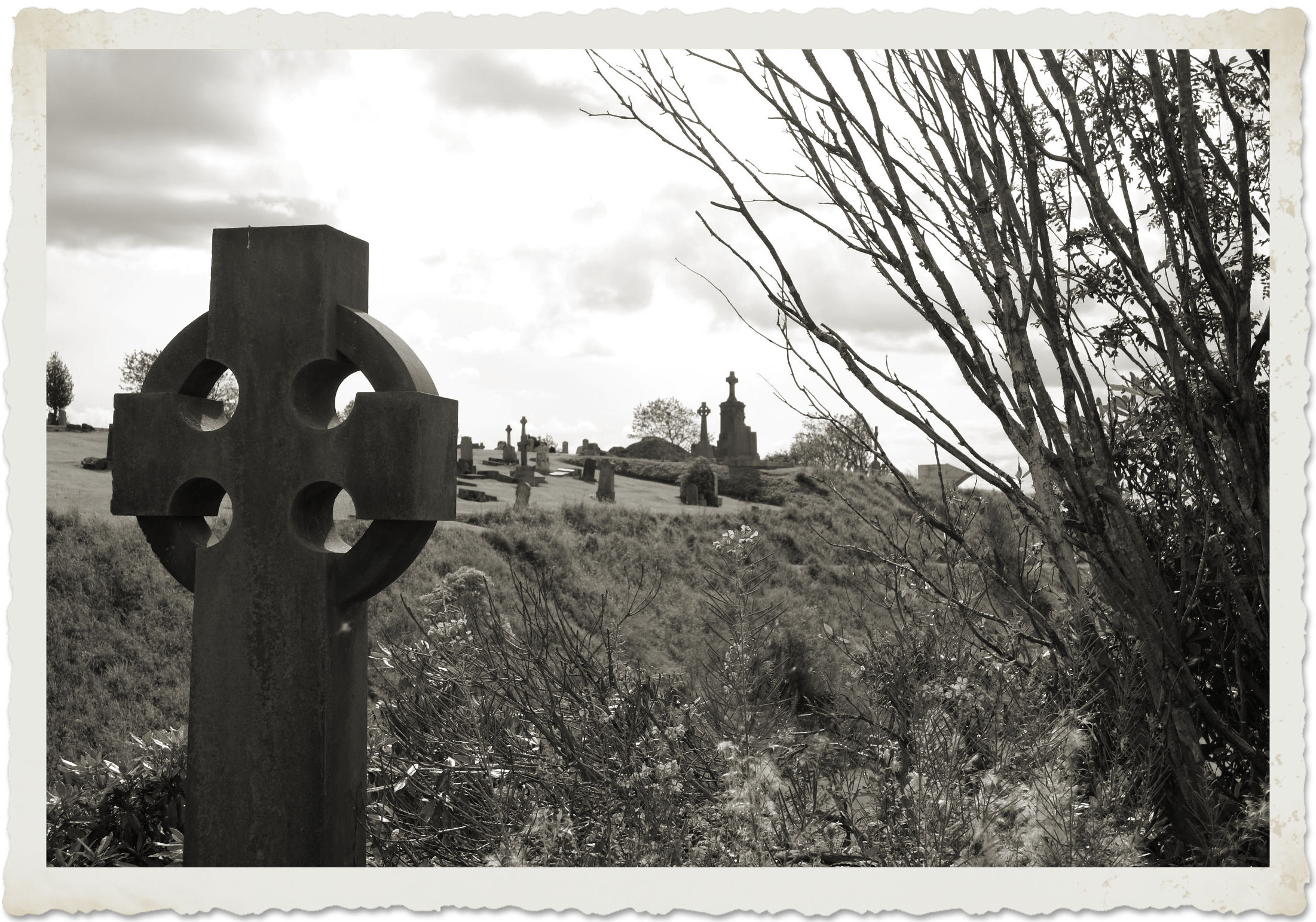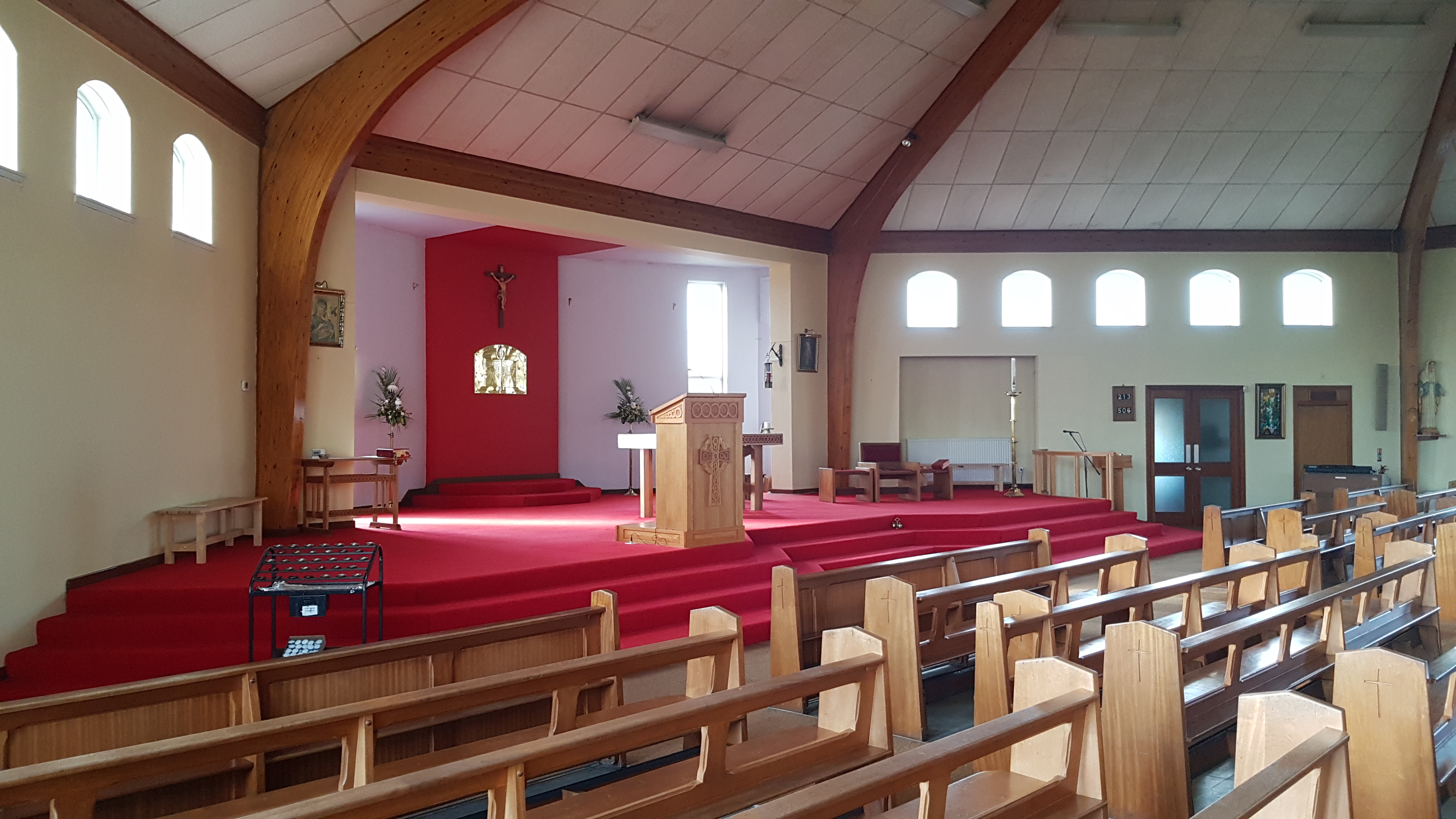[Written in 1986]
The past twenty-five years many people have contributed to the growth and development of Serf’s parish. The majority will always remain the background, without general public recognition, but needless to say, without their help and support there could never have been a parish. If St. Serf’s can be looked on now as a thriving Catholic Christian community then much of the credit must go to the parishioners who provided, by the grace of God, the foundation and the seed-bed upon which the parish was built and from which it continues to grow. The clergy too, over the past years, have made their impression on the parish. Some have had more time than others in which to make that impression.
Fr. Lillis and Fr. Power, the two longest serving parish priests and Fr. D’Arcy.the longest serving assistant priest, gave many years of their lives to the parish. With the rest of the priests who served St. Serf’s, we can only thank them for their dedication and concern in the way they guided their people and formed them with their knowledge, insigh, talents and their faith.
In September of 1961 the parish of St. Serf’s was founded in Airdrie and its first parish priest was Fr. Richard Lillis. At that time it had an estimated Catholic population of around 1,000 parishioners, with no church and no chapel house. In these early days, Fr. Lillis resided in St. Margaret’s chapel house in Halicraig Street and working from there he looked after the needs of the people. Mass was celebrated in St. Serf’s primary school hail for the first time, on Sunday 17th September 1961.

A house was found fairly quickly and Fr. Lillis took up residence on 28th of November 1961. The house ’Inzievar’- was a large Georgian mansion, one half of which was owned and occupied by members of the Taylor family of Airdrie. This house became the centre of the parish and later the adjoining ground provided the site for the new church.
Like any new development, the building of the parish and the church demanded a great deal of organisation and negotiation, not to mention a great deal of hard physical work. But Fr. Lillis, assisted by an able and enthusiastic congregation, rose to the occasion, accepted the challenge, and led them mainly by his example. These early years were demanding but rewarding years. Years which created a bond between Fr. Lillis and the parishioners. A bond experienced even yet, twenty-five years later. Fr. Lillis was to remain in St. Serf’s for eleven years and from here he went to St. Patrick’s in Wishaw where sadly he died on the 12th of February 1973. Before the church was built, St. Serf’s primary school hall provided not only a place for the celebration of mass, it also became the venue for weddings. Many of the ladies of the parish will remember, in the days of stiletto heels, having to put small covers on their heels to protect the floor of the hall.
Fund raising was very much a part of parish life and a necessity if the parish was to have its own church. The Friday night Building Fund was established, Prize Bingo Nights, Garden Fetes and Sales of Work were organised, as were other money-making ventures. But fund raising wasn’t the only preoccupation. Other needs, spiritual and social, were catered for throughout the years. There were bus trips to Ayr and Burntisland. The ‘Fair Monday’ outing to Ayr—even in the rain—with five and some-times six coaches—provided a change of scenery and a chance to relax. These outings continued until 1968, long after the church was built. There was the annual St. Patrick’s night Dance in the Sir John Wilson Town Hall and the Christmas Dance in the Tudor Hotel. These were always well supported. These functions and activities did more than just raise money for the building of the new church, they brought the parish together and with a common goal, united the people, formed them and gave them an identity as a parish.

Many different groups were formed by Fr. Lillis. These groups were continued and added to by his successors Fr. Power and Fr. McColgan. Some of these original groups are still operating very successfully.
St. Vincent de Paul Society.
V.I.P. Committee (Cater for the older members of the parish).
Union of Catholic Mothers.
Legion of Mary.
500 Club.
Altar Servers.
Church cleaners.
Pro-life Cell.
Sacristans.
Simanna Club (Senior Citizens).
Religious Stall Group.
Alanon Group.
Catechists.
Covenant Scheme.
Retreat Group.
Lourdes Group.

Some of the earliest groups that were organised included: Catechists, who assisted with the preparation of parents prior to their children receiving the sacraments; Cana Conferences, to prepare engaged couples for the sacrament of Marriage; Covenant Scheme, started in 1964; the men of the parish went on retreat to Craighead and this was organised by Eddie Harkins assisted by Ted Wylie; The first sacristan was Ellen Borthwick who was succeeded by Charlie O’Brien; The first pass-keepers were John Rogan, Joe Reilly, Arthur Brannigan and Willie Lamb; The bulletin, or the “Messenger” as it was called at that time, was produced by Mrs. Toner the school secretary; groups of men went from the parish to Buchlyvie where the Kiltegan Fathers were opening their college. Fr. Lillis encouraged them to assist in the clearing of the grounds, decorating the buildings and assisting generally about the place; from his great devotion to Our Lady of Lourdes, Fr Lillis started the annual pilgrimage to Lourdes from the parish. In 1963 when this was started, the cost of the trip could be paid weekly and every week Paddy Devlin and his wife Margaret collected the instalments. In 1975 the Lourdes group was run by Mrs. Murtagh, Mrs. McMullin, Mrs. Wilson, Mrs. Cushnan and Mrs. Morris. Thanks to their efforts many people, the sick and disabled especially, have been sent to Lourdes. To finance these pilgrimages the ladies were involved in a variety of fund-raising projects. Their generosity was not limited to pilgrimages, it included other groups within the parish and outwith the parish. This devotion to Our Lady was instrumental in the statue of Our Lady being taken round the parish and the rosary being said in the homes of the parishioners, a practice that is still continued to this present day.

One of the most appreciated tasks tackled by Fr. Lillis and his helpers, young and older, was the ‘clean up’ of the cemetery at Stainybraes or St. Joseph’s as we know it now. This was a marathon task and many still speak of the transformation that was brought about through the sheer determination of Fr. Lillis and the hard work of so many. Thanks to him and his helpers, encouraged with beer for the older ones and sweets for the younger, the Catholics of the Airdrie district now have a place to be proud of where they can lay to rest their deceased relatives and friends.So many others were instrumental in keeping the parish alive and active. They include the gardeners, painters, electricians, flower arrangers, tea makers and the ladies who provide the baking for the tea after the morning mass but one person who does deserve special mention is Willie Delaney. Since 1961, when Fr. Lillis started the Mission Appeal, Willie has gone round the parish every year collecting for the missions. Due to his efforts, the parish can boast of being on record, the most generous parish in the British Isles with regard to the missions. Fortunately for the missions and the parish, Willie is still collecting.

Over the years, the Catholic population of the parish increased. In the Glenmavis area in particular, there were a considerable number of parishioners who had to travel into Airdrie for Mass. Initiaily a bus was provided on the Sunday morning but a more permanent and satisfactory solution was found by celebrating the mass in the village hall. Since 1970 the eleven o’clock mass on a Sunday morning in the village hall has been a regular feature in the lives of the Glenmavis parishioners. The organisation of the hail for the celebration of mass was initially in the hands of George Boyle assisted by John Lafferty. However, since George’s death (and during his long illness), this responsibility has been taken over by Phil Friel, assisted by the congregation who also provide the readers, passkeepers and the offertory processors.
The Second Vatican Council’s lead to the Church on ecumenism was taken up in St. Serf’s and it led to a close association with the neighbouring Church of Scotland parish of St. Columba.- This association with St. Columba’s and the Rev. Cohn Douglas, its minister, has been thriving since and has resulted in Unity services, discussion groups, prayer groups and also a joint visit to lona. In 1976, St. Serf’s V.I.P. committee joined with the committee from St. Columba’s to organise joint Christmas dinners for the senior citizens. This continued until 1980 when, due to increasing numbers of senior citizens in the parish, it was decided to revert back to the individual parish committees and concentrate on their own parish groups. 1963 saw the arrival of Fr. Andrew Sheahan to the parish. He came as St. Serf’s first assistant priest and before long he was attending to the sick, performing marriages, baptising babies and visiting the homes of the parishioners. He worked well with the young people of the parish, contributing to a thriving Boys Guild football team and to the youth club. As everyone knows, he had a fine voice which was heard quite recently when he sang with the ‘Holy Road Show Concert’ that came on tour to Britain from Ireland. When Fr. Sheahan left the parish in 1968, Fr. Power took his place as the new assistant priest. His love for music was a great asset to the parish.
Fr. Power remained in the parish as parish priest until 1983 and during that time he had as his assistant priests Fr. D’Arcy, Fr. Rodgers and Fr. Millar. Their work in the parish involved the sick, the young and the old, family visits, attending the schools and they did this in their own individual way with their own particular talents. They too became involved with football teams, youth clubs, pilgrimages and with all the other things that occur in a parish. It was in 1983 that Fr. Power took ill and left the parish to convalesce and Fr. Millar carried on until Fr. McColgan arrived as the new parish priest. Fr. McColgan’s interest and knowledge of Scottish history became evident. He fostered the unity that existed between the parish and St. Columba’s, our neighbouring Church of Scotland parish. He continued the ecumenical dialogue between the parishes and with parishioners from each joined in a trip to the island of lona.
As most people know, much of the popular culture of the area is dominated by the ‘Orange and the Green’ and this does no good for Scotland. So, Fr. McColgan thought that the celebration of the day in which all Scotsmen can take pride could contribute to ecumenism at the grass roots. The day chosen was ‘Bannockburn Day’, the 24th of June. The Mass of St. John the Baptist was celebrated. It was concelebrated by Fr. McColgan and his clerical friends and the blessing at the end by Fr. Angus McQueen was given in Gaelic, the language spoken by most of the Scots at Bannockburn—they would never have understood the words of the ‘Flower of Scotland’. A ‘Bannockburn Day’ challenge football match was organised between teams from St. Serf’s parish and St. Dominic’s parish, Craigend—Fr. McColgan’s previous parish.

His Celtic interests became very evident in the designs he had carved on the altar, the lectern and the baptismal font. He found in Mr. William Sinnott of Coatbridge, a craftsman whose work he admired and who could decorate the church furnishings with the designs and with the other symbols that would emphasize the Celtic Catholic Christian heritage that had produced saints like Columba and our own St. Serf.
Fr. Millar remained with Fr. McColgan for a year or so and then he was moved to St. Bride’s, Cambuslang. This was in October of 1985. To replace him, Fr. Halavage came from the neighbouring parish of St. Margaret’s and from here he continues his work as chaplain to St. Margaret’s High School. Since Fr. McColgan’s illness in the summer of this year, Fr. Sheridan has been in residence in the parish. Hopefully, through our prayers, Fr. McColgan will be back in full health before long.

Looking back over the past twenty-five years, there have been many characters who have contributed to the parish and coloured it in their own particular way. Parishioners like Willie O’Neill who was a member of the S.V.P. for 52 years and who came from St. Margaret’s parish to organize the society here in St. Serf’s: with him was Owen Herne who was the first president of the S.V.P. in the parish; There was Janet McLuskie and Ellen Riley who also assisted Fr. Power with the bands; Helen McBennett who sang at the concerts to raise money for the V.I.P.s. We mention but a few.
Many of our present parishioners have been and still are deeply involved in the parish and we take this opportunity to thank them for the charity and the time that they have sacrificed over the past years. We can only hope that in the next twenty-five years others as charitable and as dedicated will take their place. The task that faces the parish at the present time is not one of building a church of bricks and mortar but of ‘living stones’. A much more difficult task. It will make demands on our faith, as it did on those in the past. Demands on our time, our energy, our charity, on our very selves, to enable the Risen Christ to come alive in us and inspire others to live in the hope of God’s eternal Kingdom. Many thanks to all those who supplied the material for this article, especially Len Kennedy
